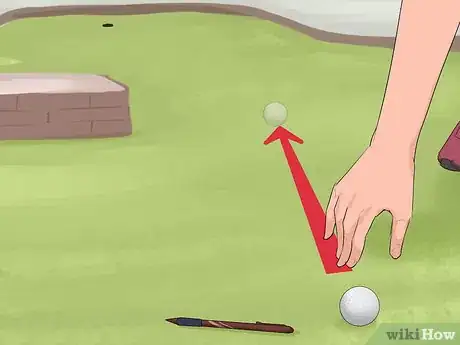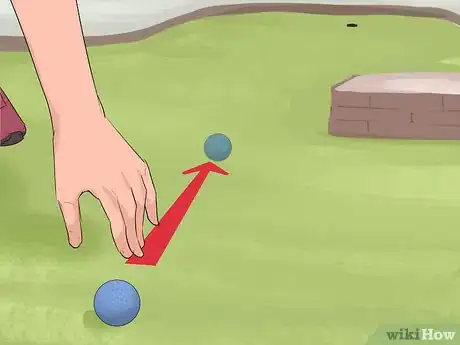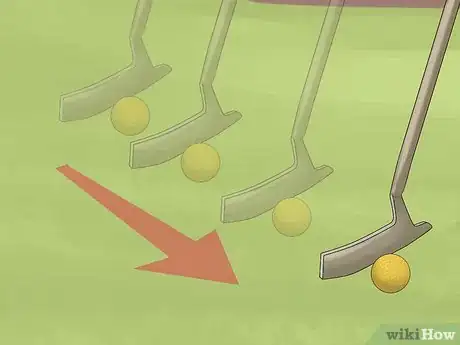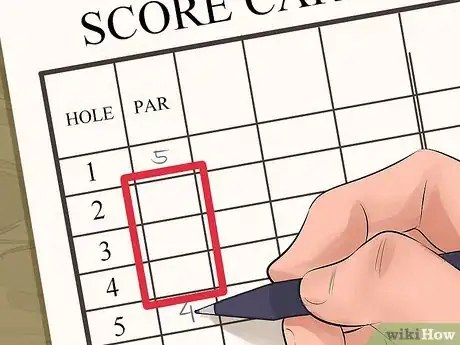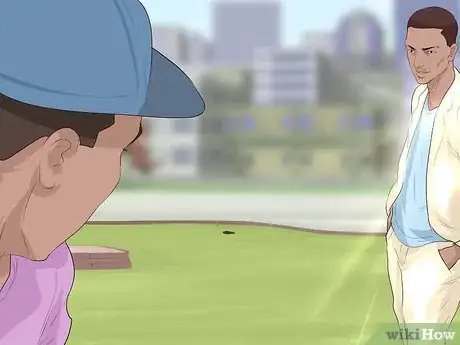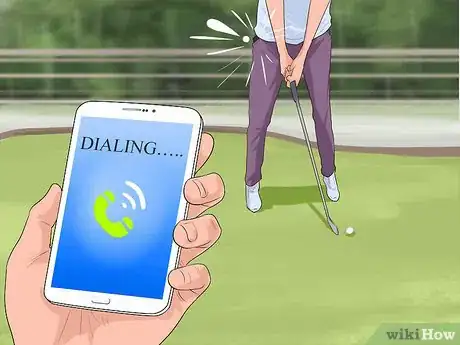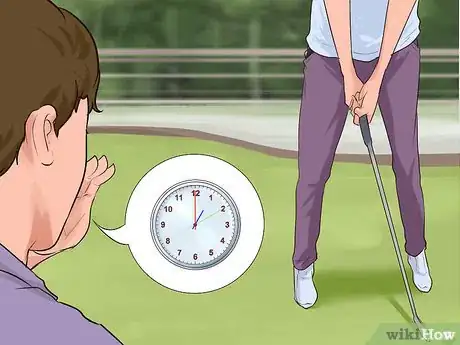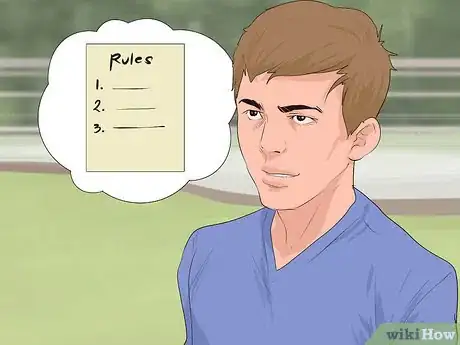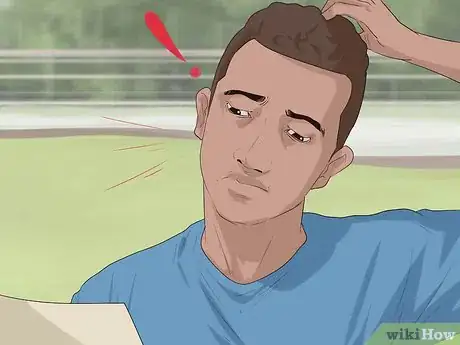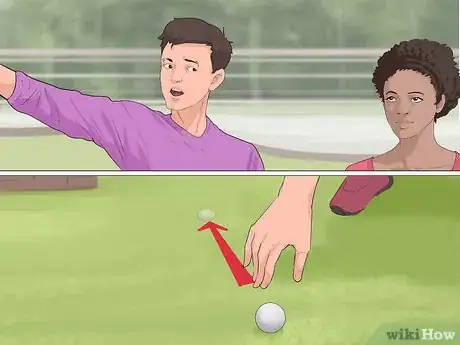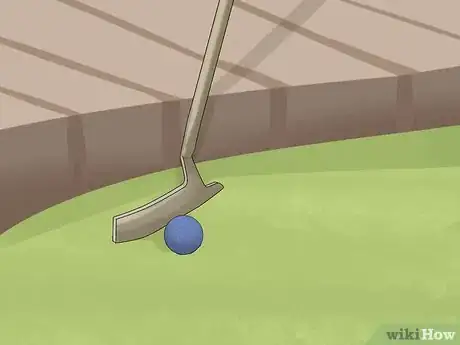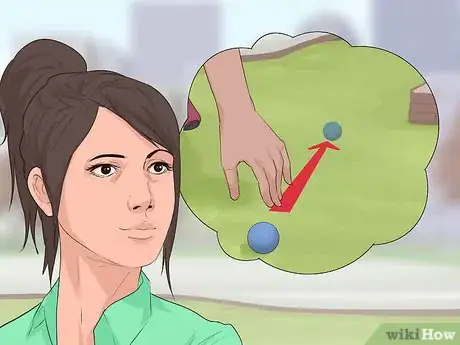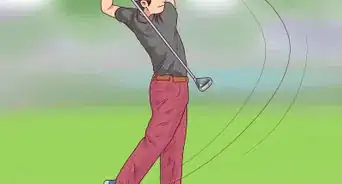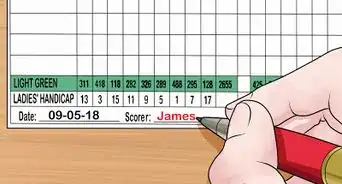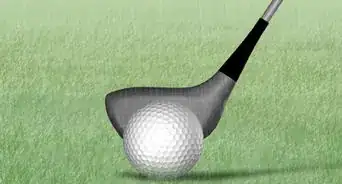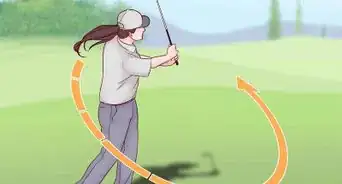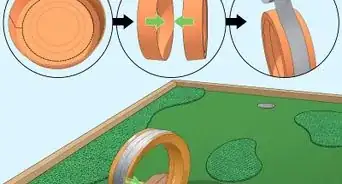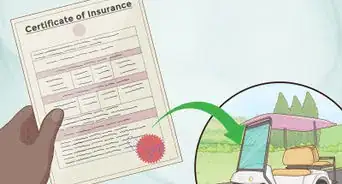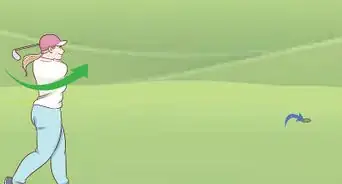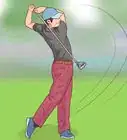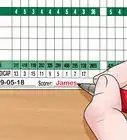X
This article was co-authored by wikiHow Staff. Our trained team of editors and researchers validate articles for accuracy and comprehensiveness. wikiHow's Content Management Team carefully monitors the work from our editorial staff to ensure that each article is backed by trusted research and meets our high quality standards.
This article has been viewed 68,919 times.
Learn more...
As with traditional golf, sometimes the most surefire way to improve your mini golf score is to cheat remorselessly. The temptation here may be even stronger–after all, who wants to be outshone by the six year-old in the next party who's playing through?
Steps
Method 1
Method 1 of 3:
Improving Your Game the Dishonest Way
-
1Reposition your ball illegally.[1] Obstacles on the course provide great cover to hide what you are doing. Once you have made your drive, quickly but nonchalantly make your way up to your ball while your opponent is still teeing off. Once their ball comes to a rest, get in position to line up your next shot as soon as possible, before your opponent reaches you, while you are still out of view. Nudge your ball into a more favorable position.
- When you first get your equipment, claim the green ball (if there is one) as your own. Assuming that the turf is green as well, a green ball will blend in much more than other colors, making it more difficult for your opponent to note its exact position once it comes to rest.
- Use your hand to move the ball. Pretend to have dropped something if needed, or act like you are wiping something off the turf, which is permitted. Nudging the ball with your putter may cause it to roll more than you meant.
-
2Reposition your ball “legally.” When the rules allow you to move your ball before taking your next stroke, make the most use of this opportunity. Improve its position a tad more favorably than what’s really allowed. Only improve it a tad, though. Don’t overreach and risk discovery.
- If your ball has come to rest against a rail or obstacle, use the length of your putter’s head to reposition your ball the allowed six inches from the rail.[2] However, unless your opponent is hovering over your shoulder, watching your every move, set your putter’s head down a centimeter or two away from the rail/obstacle. Then set your ball a centimeter or two away from the end of your putter’s head.
- If your opponent’s ball knocks yours out of position, you are allowed to set your ball back where it was.[3] Take a gamble and assume their attention was focused more on where their own ball was headed rather than where yours was originally. Place your ball a smidge closer to a more favorable position.
Advertisement -
3Play hockey, not golf. When you putt, follow through with your putter as you would with a hockey stick. Guide the ball’s direction. Add more force to your ball’s momentum to cover more distance if needed.[4] Legally, your ball should only be propelled forward by the tap of your putter, so you will have to be subtle about this if your opponent (or anyone else) is paying close attention. To do it effectively without calling attention to it, practice this on your own first.
-
4Fudge your scorecard hole by hole. Technically your score is supposed to be kept by someone other than yourself,[5] but if your opponent doesn’t know that, go with the honors system and mark your own scores. Then promptly abuse their trust in you. Shave a point off here and there.[6]
- Be sensible about which holes you fudge. Other players will most likely remember those holes where you maxed out the number of permitted strokes. They would also most likely remember any holes-in-one you supposedly scored. Only shave off a point or two from your less memorable, midrange scores.
-
5Fudge your scorecard after the fact. "Forget" to mark your scores for a couple of holes. Give your opponent time to forget exactly how many strokes you took two holes ago before marking your points for that hole. When you add up your score at the end of the game, "forget" to include a hole or two in your total to shave off a few more points.
Advertisement
Method 2
Method 2 of 3:
Messing with Your Opponent’s Head
-
1Wear eye-catching clothes. Distract your opponent with your wardrobe. If it’s sunny out, wear bright, reflective clothing and/or jewelry that will catch the sun when you stand in your opponent’s line of sight. If it’s raining or seems like it might start to, bring an umbrella along and “unconsciously” tap it on the ground or against your thigh while they putt. If it’s windy, wear loose clothes that flap excessively.
- Official games and tournaments may have dress codes.[7] Dress within these limits as best as you can.
-
2Use their cellphone against them. Keep your own cellphone on during the game. Have your opponent’s number ready to dial. As they line up a critical shot, wait for them to swing. As soon as they draw up their backswing, “accidentally butt-dial" them to throw them off.[8]
- In an official game, all cellphones must be turned off.[9] If you have a willing partner-in-crime, have them call your opponent during the game in case they left theirs on.
-
3Distract your opponent. Keep plenty of change and/or keys in your pocket. Jostle them around “absently” as your opponent tees off or putts.[10] Sniff, sneeze, or cough when they swing. Act startled by an imaginary bee. Be strategic about when you do this to avoid accusations.[11]
- If the game is supervised by a judge or referee, make a show of trying your best to not distract your opponent. Fake a few sneezes here and there and mention allergies to establish credibility. When it is your opponent’s turn to play, stay within their line of sight and pretend to fight down a sneeze. Create an air of suspense that will take their mind off their own game.
-
4Rush your opponent. Utilize the party behind you, who has to wait for you and your opponent to finish each hole before they can advance.[12] Slow your own game down as much as possible so the other party has plenty of time to finish the hole behind you. Then comment to your opponent how people are waiting for the two of you to finish up. Make your opponent feel as though the onus is on them to hurry up and free the hole for the next party.
- According to strict rules, the first player to tee off at any given hole has 90 seconds to do it once they reach it. Use all 90 seconds to give the next party more time to catch up.
Advertisement
Method 3
Method 3 of 3:
Explaining the Rules to Rookie Opponents
-
1Keep rules to yourself. If you are playing a casual game and your opponent is unfamiliar with the rules, be selective about which ones you share. Depending on your weaknesses, keep mum about those that will prevent you from winning. “Forget” to inform them of others right up until a situation occurs when those rules benefit your game.
- Offer to pay for the round. The rules of the course are often posted by the cashier, so tell your opponent that you will take care of paying and collecting equipment while they just “hang out over there,” where they won’t see the posting.
-
2Confuse “points” and “strokes.” According to strict rules, when you fill out your scorecard after each hole, you add a point for each stroke you took. However, every course has a maximum number of strokes allowed per hole. For time’s sake, when you are one stroke away from reaching the maximum and still haven’t holed your ball, you are supposed to automatically add the last point without bothering to actually take the stroke, since it makes no difference in the end.[13] When you explain this rule to your opponent, word it in a confusing manner so they will take an extra stroke and score an extra point (remember: the lowest score wins). For example:
- If the course has a seven-stroke limit, you are supposed to automatically score a “7” on your card if you still haven’t holed the ball after six strokes. Instead of specifying this, explain the rule in vaguer terms. Make the concept clear and keep referring to the “seven-stroke limit,” but don’t clarify any other numbers. Fool them into thinking that they should play seven strokes and then automatically score themselves an “8.”
-
3Force them to play longer drives. When you play holes that feature a sharp incline rising from the tee-off area, wait to see if your opponent’s ball ends up rolling all the way back. Watch to see how they attempt their second drive. Technically, if your ball rolls over and past the tee-off line on its way back to you, you are allowed to place it back on the tee-off line at the exact spot where it crossed.[14] If your opponent is unaware of this, let them play from where their ball comes to rest. The extra distance that they have to cover may lead to yet another stroke.
- The more often this happens, the more suspicious they will be if you end up needing to make use of this rule later on. The first time it happens, pretend to be distracted by something else and make a point of looking away when they line up and make their second drive. If it happens again, do the same thing. But after that, inform them of the rule as if you only just noticed what they were doing and apologize for not having caught it sooner.
-
4Let your opponent play balls from the edge. If your ball comes to rest near the very edge of the fairway or green, you are allowed to reposition your ball by setting it the length of your putter’s head away from the edge, so you have enough room for a clean stroke.[15] Leave this unmentioned unless you need to do it. Until then, let your opponent play their own ball as it lies, regardless of where that is.
- If you need to reposition your ball, do so without comment and, if possible, when your opponent isn’t looking. If you can do it without being noticed, don’t mention what you did.
- If your opponent notices you repositioning your ball and asks what you’re doing, muddle your phrasing as you explain the rule. Technically, you can reposition your ball whenever it is “near” the edge[16] . Confuse this with “at” or some other term that makes it seem like you can only do this when your ball is physically touching the edge. This way they will continue to play some balls that they would otherwise be allowed to reposition.
- The same rule applies to repositioning your ball if it comes to rest within six inches of an obstacle.[17] Leave this rule unmentioned as well until you need to utilize it.
-
5Make them play “dirty.” Technically, you are allowed to clean your ball and/or the course at any time once the ball is in play, as long as it isn’t actually moving.[18] Unless you need to do a little cleaning to improve your own game, don’t share this with your opponent. Force them to play balls covered in grime or about to travel through a hazard that isn’t actually part of the course.
- This is a less suspicious rule to leave unmentioned. You probably won’t need to handle their ball at all, so you would have no way to know that it’s dirty.
Advertisement
Warnings
- Official tournaments will have referees supervising your game, which means some of these techniques will be too obvious to use.⧼thumbs_response⧽
Advertisement
References
- ↑ http://www.badgolfer.com/departments/features/ways-to-cheat-1315.htm
- ↑ https://crec.unl.edu/im/rules/Mini_Golf.pdf
- ↑ http://www.abitbackward.com/2011/06/10-great-ways-to-cheat-at-mini-golf.html
- ↑ http://www.abitbackward.com/2011/06/10-great-ways-to-cheat-at-mini-golf.html
- ↑ http://prominigolf.com/wp-content/uploads/2013/08/Members-Rulebook.pdf
- ↑ http://www.badgolfer.com/departments/features/ways-to-cheat-1315.htm
- ↑ http://prominigolf.com/wp-content/uploads/2013/08/Members-Rulebook.pdf
- ↑ http://www.badgolfer.com/departments/features/how-to-cheat-in-golf-II-1538.htm
- ↑ http://prominigolf.com/wp-content/uploads/2013/08/Members-Rulebook.pdf
- ↑ http://www.badgolfer.com/departments/features/cheating-in-golf-chapstick-10096.htm
- ↑ http://www.badgolfer.com/departments/features/ways-to-cheat-1315.htm
- ↑ http://prominigolf.com/wp-content/uploads/2013/08/Members-Rulebook.pdf
- ↑ http://prominigolf.com/wp-content/uploads/2013/08/Members-Rulebook.pdf
- ↑ http://prominigolf.com/wp-content/uploads/2013/08/Members-Rulebook.pdf
- ↑ http://www.abitbackward.com/2011/06/10-great-ways-to-cheat-at-mini-golf.html
- ↑ http://www.abitbackward.com/2011/06/10-great-ways-to-cheat-at-mini-golf.html
- ↑ https://crec.unl.edu/im/rules/Mini_Golf.pdf
- ↑ http://prominigolf.com/wp-content/uploads/2013/08/Members-Rulebook.pdf
About This Article
Advertisement
